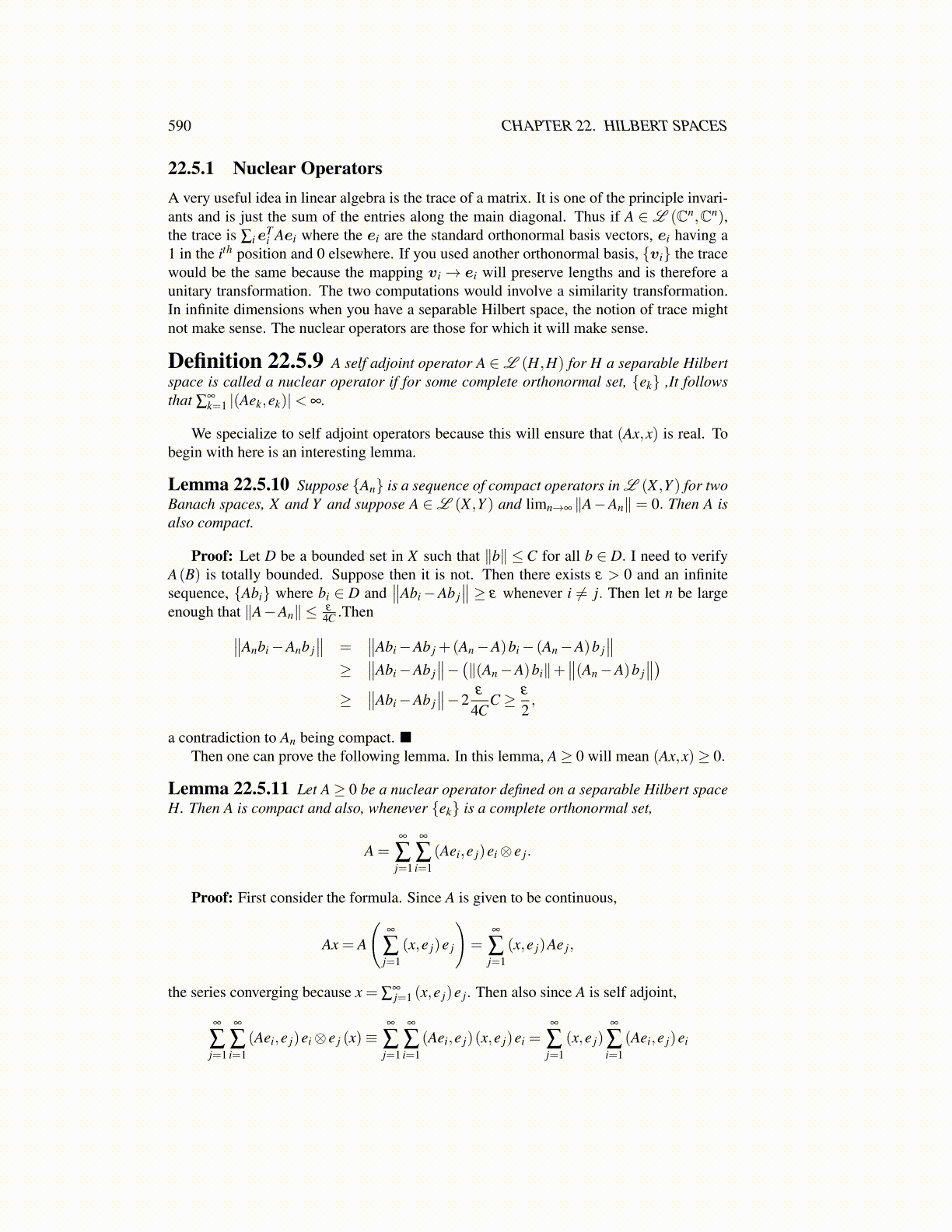
590 CHAPTER 22. HILBERT SPACES
22.5.1 Nuclear OperatorsA very useful idea in linear algebra is the trace of a matrix. It is one of the principle invari-ants and is just the sum of the entries along the main diagonal. Thus if A ∈L (Cn,Cn),the trace is ∑ie
Ti Aei where the ei are the standard orthonormal basis vectors, ei having a
1 in the ith position and 0 elsewhere. If you used another orthonormal basis, {vi} the tracewould be the same because the mapping vi → ei will preserve lengths and is therefore aunitary transformation. The two computations would involve a similarity transformation.In infinite dimensions when you have a separable Hilbert space, the notion of trace mightnot make sense. The nuclear operators are those for which it will make sense.
Definition 22.5.9 A self adjoint operator A ∈L (H,H) for H a separable Hilbertspace is called a nuclear operator if for some complete orthonormal set, {ek} ,It followsthat ∑
∞k=1 |(Aek,ek)|< ∞.
We specialize to self adjoint operators because this will ensure that (Ax,x) is real. Tobegin with here is an interesting lemma.
Lemma 22.5.10 Suppose {An} is a sequence of compact operators in L (X ,Y ) for twoBanach spaces, X and Y and suppose A ∈L (X ,Y ) and limn→∞ ∥A−An∥ = 0. Then A isalso compact.
Proof: Let D be a bounded set in X such that ∥b∥ ≤C for all b ∈ D. I need to verifyA(B) is totally bounded. Suppose then it is not. Then there exists ε > 0 and an infinitesequence, {Abi} where bi ∈ D and
∥∥Abi−Ab j∥∥ ≥ ε whenever i ̸= j. Then let n be large
enough that ∥A−An∥ ≤ ε
4C .Then∥∥Anbi−Anb j∥∥ =
∥∥Abi−Ab j +(An−A)bi− (An−A)b j∥∥
≥∥∥Abi−Ab j
∥∥− (∥(An−A)bi∥+∥∥(An−A)b j
∥∥)≥
∥∥Abi−Ab j∥∥−2
ε
4CC ≥ ε
2,
a contradiction to An being compact. ■Then one can prove the following lemma. In this lemma, A≥ 0 will mean (Ax,x)≥ 0.
Lemma 22.5.11 Let A≥ 0 be a nuclear operator defined on a separable Hilbert spaceH. Then A is compact and also, whenever {ek} is a complete orthonormal set,
A =∞
∑j=1
∞
∑i=1
(Aei,e j)ei⊗ e j.
Proof: First consider the formula. Since A is given to be continuous,
Ax = A
(∞
∑j=1
(x,e j)e j
)=
∞
∑j=1
(x,e j)Ae j,
the series converging because x = ∑∞j=1 (x,e j)e j. Then also since A is self adjoint,
∞
∑j=1
∞
∑i=1
(Aei,e j)ei⊗ e j (x)≡∞
∑j=1
∞
∑i=1
(Aei,e j)(x,e j)ei =∞
∑j=1
(x,e j)∞
∑i=1
(Aei,e j)ei